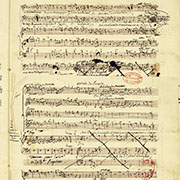King Louis XV thinks highly of Rameau’s Daphnis et Églé (1753). But following performances in Fontainebleau, the pastorale héroïque was never staged again during Rameau’s lifetime. With this publication as part of the Opera omnia an authoritative edition is now available.
Daphnis et Églé, a one-act opera or pastorale héroïque, was performed once and only once, before King Louis XV, at Fontainebleau, on 29 October 1753. The work was never performed elsewhere, either in the city or at court, and it was never published, not even in the monumental edition—Jean-Philippe Rameau, Œuvres complètes—published under the supervision of Camille Saint-Saëns. It was only in 2014, on the 250th anniversary of the composer’s death, that the opera was revived in a modern stage performance by William Christie and Les Arts Florissants. Because of its obscurity, Daphnis et Églé, unlike most of Rameau’s other works, was never subject to revision. The only changes of which we are aware are those made during the rehearsals: the changes occur essentially in the second divertissement; they appear very clearly in the manuscript copies of the separate parts, and concern just the inversion of the order of certain dances and the elimination of the ariette for Églé, “L’Amour règne sur nos cœurs,” which was replaced by the ariette for Daphnis, “Oiseaux, chantez.” We have had to reconstruct the missing vocal part of Églé’s ariette. In establishing the text of the present edition, we have used Rameau’s autograph manuscript, the separate parts and the libretto printed by Ballard in 1753. For matters that are not entirely clear in the autograph, we have also consulted the copy preserved in the fonds Decroix. The present edition offers the original version of the second divertissement, abandoned by Rameau during rehearsals, as an Appendix.
Rameau seems to have received the commission for Daphnis et Églé at the end of 1752, in anticipation of the King’s projected visit to Fontainebleau in the autumn of 1753. Unfortunately, Collé’s own personal diary, the Journal historique, offers no information about the collaboration between the librettist and the composer, because it lacks entries for the years 1752 and 1753. It is nevertheless clear that the work was completed before the end of the summer of 1753: on 13 September 1753, the copyist Jean Rollet presented an invoice, countersigned by the composer, to Louis Bay de Curis, the director and general controller of the King’s division of Argenterie, Menus-Plaisirs et Affaires, for the various copies he had made of a number of scores, including those of Sybaris, Lisis et Délie, and Daphnis et Églé (Archives nationales, O1 2993, Pièces justificatives des comptes, 1753, dossier I, Voyage de Fontainebleau, document 1). According to a note that is headed “musical rehearsals in Paris,” the rehearsals were held at the Académie royale de Musique on 26, 27 and 29 September 1753, as well as on 1, 3, 5, 10 and 11 October of that year. This document is of particular interest because it gives the precise number of rehearsals at which each musician was present. The pastorale Daphnis et Églé was performed only after various celebrations associated with the birth, on 8 September 1753, of Xavier Marie Joseph, duc d’Aquitaine, had been completed. As was customary, the maréchal de Richelieu, whose title was “Premier gentilhomme de la Chambre du roi,” and the director of the Menus-Plaisirs (the office of ceremonies, festivities, and events), were charged with the organization of various entertainments. For these performances, Rameau was present at Fontainebleau for some thirty-eight days, as we know from an invoice from the Menus-Plaisirs that details the lodgings provided to the performers, including the singers: here we read that Rameau, with Louis de Boissy, had lodgings in Fontainebleau at the home of a certain Romet. (The invoice tells us nothing of the presence or absence of Collé.) For this visit, as was the case for all the artists participating in these festivities, Rameau received a payment, which included a gratuity and an amount to cover the cost of room and board, of 2,400 pounds: this sum is greater than those received by the directors of the King’s Chamber Music, François Rebel and François Francœur, who were each paid 1,200 pounds.
The printed libretto gives the names of the performers involved in the first performance of the work: M. Jéliote (Daphnis), Mlle Fel (Églé), M. Gélin (the High Priest of the Temple of Friendship), and Mlle de Riancour (Cupid). The chorus comprised six women and fourteen men. The corps de ballet was divided into shepherds and shepherdesses, for the first and second divertissements (five men and six women), Cupid’s entourage (four men and four women as well as one shepherdess), and shepherd-boy and shepherd-girls (one man and two women). The choreography of the ballets was carried out by Antoine Bandieri de Laval, who had been ballet master to the King since 1739.
Sylvie Boissou
(from [t]akte 2/2017)



